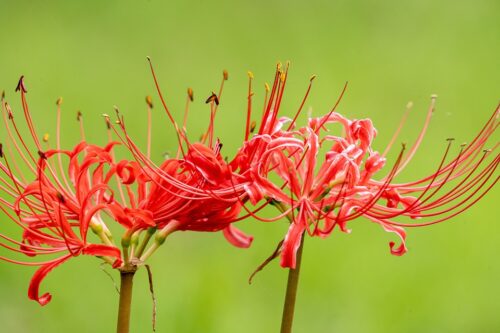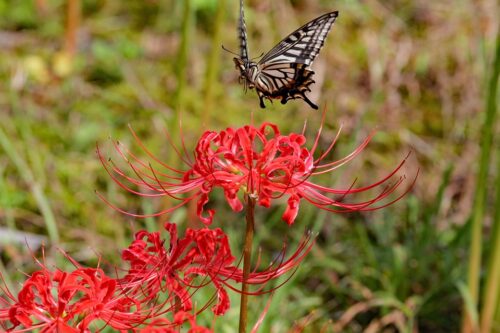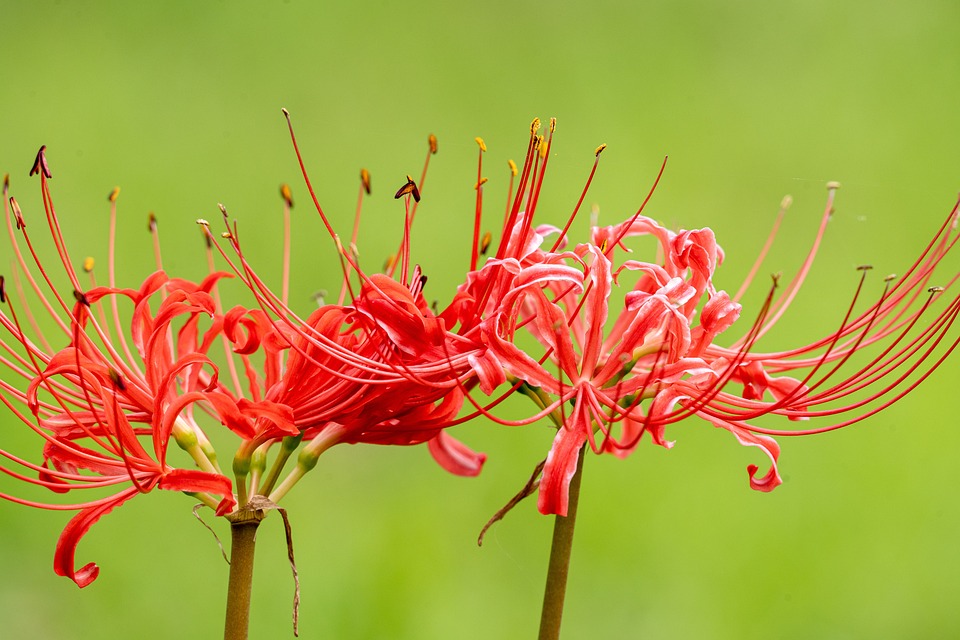Red Spider Lily is an ideal choice for planting alongside annuals and perennials to add a burst of color in late summer and early fall.
The red spider lily might just be a perfect choice for bringing lively color to your yard. Read the tips to help you get the most out of this stunning plant.
Botanical Name: Lycoris radiata
Common Names: Red Spider Lily, Equinox Flower, Hurricane Lily, Red Surprise Lily, Naked Lily, Red Magic Lily, Red Surprise Lily
USDA Zones: 7-11
Flowering Time: Summer to Early Fall
Read: Rose of Jericho Care
Red Spider Lily Information

The red spider lily is native to Asia; it has successfully adapted and naturalized in the southeastern region of the United States. While not classified as invasive, it spreads rapidly.
While most plants prepare for winter, the red spider lily begins its growth cycle. Following a period of summer dormancy, this member of the amaryllis family produces tall flower stalks with clusters of striking red blossoms. A single bulb can yield up to four stems that emerge from late August to October, growing more than a foot in just seven days. These flowers last approximately two weeks, gradually fading to a lighter pink shade.
How to Propagate Red Spider Lily
You can propagate Red spider lilies through bulbs, as they do not produce seeds. Do this process during the plant’s dormant period, which occurs during the summer. Remember that the bulbs may take some time to establish fully and may not produce blooms for the same year or the following year, depending on the extent of their root systems. Here are the steps to follow:
- Water the bulbs to soften the soil.
- Use a spade to gently dig up the bulbs, taking care not to damage them.
- Separate the bulbs by gently pulling them apart.
- Choose suitable planting sites for the bulbs, spacing them at least 6 inches apart.
- Replant the bulbs in the chosen sites, making sure to cover them with soil and water them thoroughly.
Growing Red Spider Lily in Pot
In case the winter weather in your area is too harsh for red spider lilies to grow in a perennial flower bed, container gardening is a viable option. For optimal growth, it is recommended to use a generously organic soil mix in large and deep containers that can accommodate the root system.
It is worth noting that the size of the container plays a crucial role in the flowering process; hence, it must be big enough.
To encourage blooming, it is recommended to plant the bulbs with their pointy end up, such that they are just visible above the soil surface.
Similarly, it is advisable to space the bulbs 6 to 8 inches apart in a container, similar to planting them in the ground.
Read: Monkey Cup Plant Care
Red Spider Lily Varieties
This particular plant is typically available for purchase in its pure species form, which may come in one of two naturally occurring variations:
Lycoris radiata var. radiata: This variation is sterile, which means it does not produce seeds. As a result, it is able to focus all of its energy on blooming and producing bulbs. It spreads quickly and vigorously through bulb propagation, making it an ideal option for naturalizing.
Lycoris radiata var. pumila: This is a smaller and less commonly found variety that reproduces through seeds.
There are two famous cultivars to choose from are;
- ‘Red Sunset’: In contrast, this variety produces flowers with a slightly more red-pink tone.
- ‘Fire Engine‘: This cultivar boasts vibrant, bright red flowers that are quite striking.
Ideal Growing Conditions for Red Spider Lily
Light
Red spider lilies can grow in both full sun and partial shade. For optimal flowering, partial shade is recommended. Additionally, the plant is likely to bloom earlier in partially shaded areas compared to those exposed to full sun.
Soil
Plant it in soil that is well-draining and rich in organic matter. Space each bulb approximately 8 inches apart, with the neck of the bulb sticking out just above the ground level. This planting method will promote healthy flowering of the plant.
Water
In summer, when the red spider lily is dormant, it thrives in dry soil. The plant has deep roots that can access water reserves deep in the soil, and therefore, overwatering during this period can cause bulb rot.
Once the growing season commences, indicated by the buds forming, it is advisable to keep the soil moderately moist but not saturated. If there is a lack of rainfall, water the plant as necessary.
Tip: Generally, the standard “1 inch per week” rule is more than enough for the plant to thrive in average soil.
Temperature and Humidity
The red spider lily is a sturdy plant that can endure different weather conditions in growth zones 6 to 10. However, it is advisable to cover the leaves and exposed bulbs with a layer of mulch during winter freezes, especially in zones 6 and 7.
After its blooming period, the red spider lily develops new leaves that may remain evergreen in warmer areas and persist through the winter until they die back in the spring. The plant then enters a dormant phase until new growth commences in the summer.
Red Spider Lily Care

Fertilizer
During spring, feed the plant with a high-nitrogen fertilizer into the soil, which will supply nutrients to the plant for summer and fall growth. After the flowering period, it is advisable to add a fertilizer that is rich in potassium and phosphorus to promote root development. It will also enhance the ability of the plant to withstand winter conditions.
Pruning
Pruning is not essential for this plant, but you can do this to keep the plant tidy. It is crucial to avoid pruning the flower while its foliage is yellowing since the bulb absorbs nutrients to produce its best blooms in the following year.
Instead, it is advisable to wait until the foliage has completely withered and dried up before pruning.
Overwintering
For those living in the colder regions of the spider lily’s growth zones, which are zones 6 and 7. It is advisable to add a layer of mulch around the plants in the fall to provide protection to the bulbs during the winter. In case you have planted them in containers, it is recommended to move them indoors during the winter season to safeguard them from the cold.
Note: However, keep them out of reach of pets and small children as they are toxic.
Pests and Diseases
The red spider lily is a resilient plant that does not have any identified pests or diseases. Additionally, it is deer-resistant.
However, excessive watering can cause bulb rot. So it is important to be cautious in watering. On the other hand, the red spider lily is highly attractive to a variety of pollinators, such as bees, butterflies, and birds.
Read: Carnivorous Butterworts Care
Toxicity
It is important to note that the red spider lily, as well as other plants belonging to the Amaryllis family, contain lycorine compounds which can have a mild toxic effect on humans and pets.



